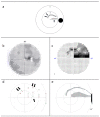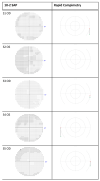Rapid Campimetry-A Novel Screening Method for Glaucoma Diagnosis
- PMID: 35456248
- PMCID: PMC9031552
- DOI: 10.3390/jcm11082156
Rapid Campimetry-A Novel Screening Method for Glaucoma Diagnosis
Abstract
One of the most important functions of the retina-the enabling of perception of fast movements-is largely suppressed in standard automated perimetry (SAP) and kinetic perimetry (Goldmann) due to slow motion and low contrast between test points and environment. Rapid campimetry integrates fast motion (=10°/4.7 s at 40 cm patient-monitor distance) and high contrast into the visual field (VF) examination in order to facilitate the detection of absolute scotomas. A bright test point moves on a dark background through the central 10° VF. Depending on the distance to the fixation point, the test point automatically changes diameter (≈0.16° to ≈0.39°). This method was compared to SAP (10-2 program) for six subjects with glaucoma. Rapid campimetry proved to be comparable and possibly better than 10-2 SAP in identifying macular arcuate scotomas. In four subjects, rapid campimetry detected a narrow arcuate absolute scotoma corresponding to the nerve fiber course, which was not identified as such with SAP. Rapid campimetry promises a fast screening method for the detection of absolute scotomas in the central 10° visual field, with a potential for cloud technologies and telemedical applications. Our proof-of-concept study motivates systematic testing of this novel method in a larger cohort.
Keywords: arcuate scotoma; automated static perimetry; glaucoma; rapid campimetry; telemedicine; visual field defect.
Conflict of interest statement
Fabian Müller received no support for the present manuscript but he had funding for the patenting with H & M Medical Solutions GmbH. Other authors had none. The authors declare no conflict of interest.
Figures





References
-
- Nakanishi M., Wang Y.-T., Jung T.-P., Zao J.K., Chien Y.-Y., Diniz-Filho A., Daga F.B., Lin Y.-P., Wang Y., Medeiros F.A. Detecting Glaucoma with a Portable Brain-Computer Interface for Objective Assessment of Visual Function Loss. JAMA Ophthalmol. 2017;135:550–557. doi: 10.1001/jamaophthalmol.2017.0738. - DOI - PMC - PubMed
Grants and funding
LinkOut - more resources
Full Text Sources
Miscellaneous

